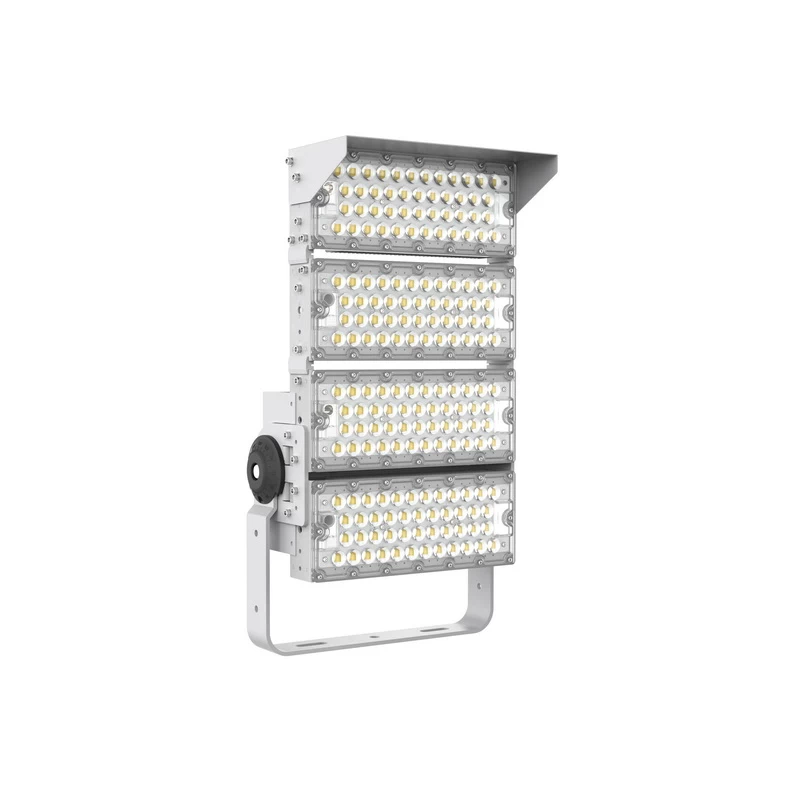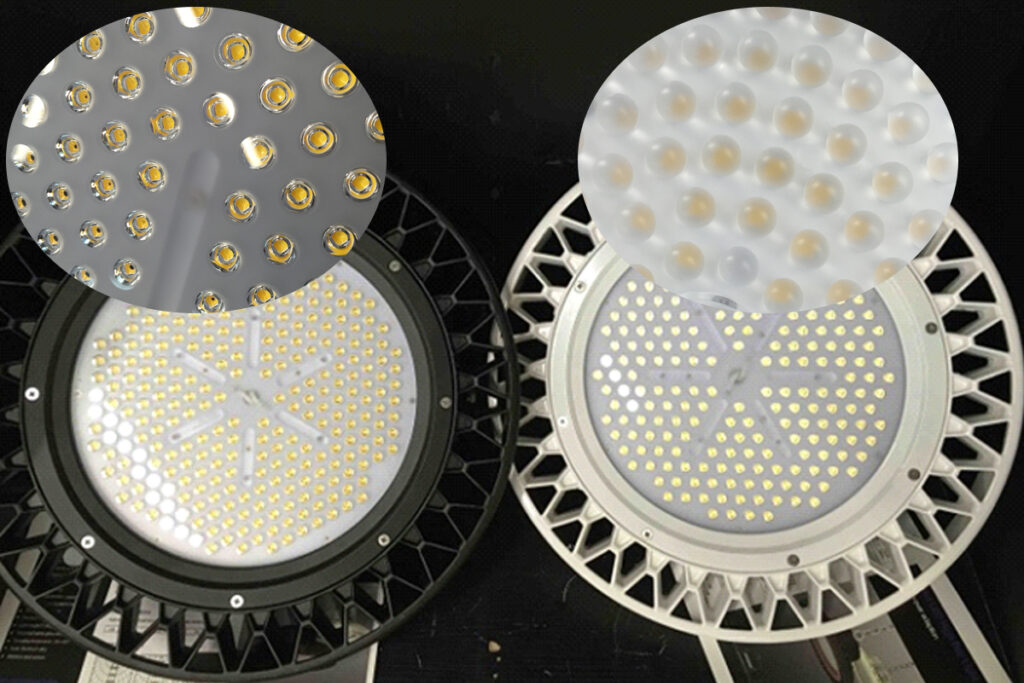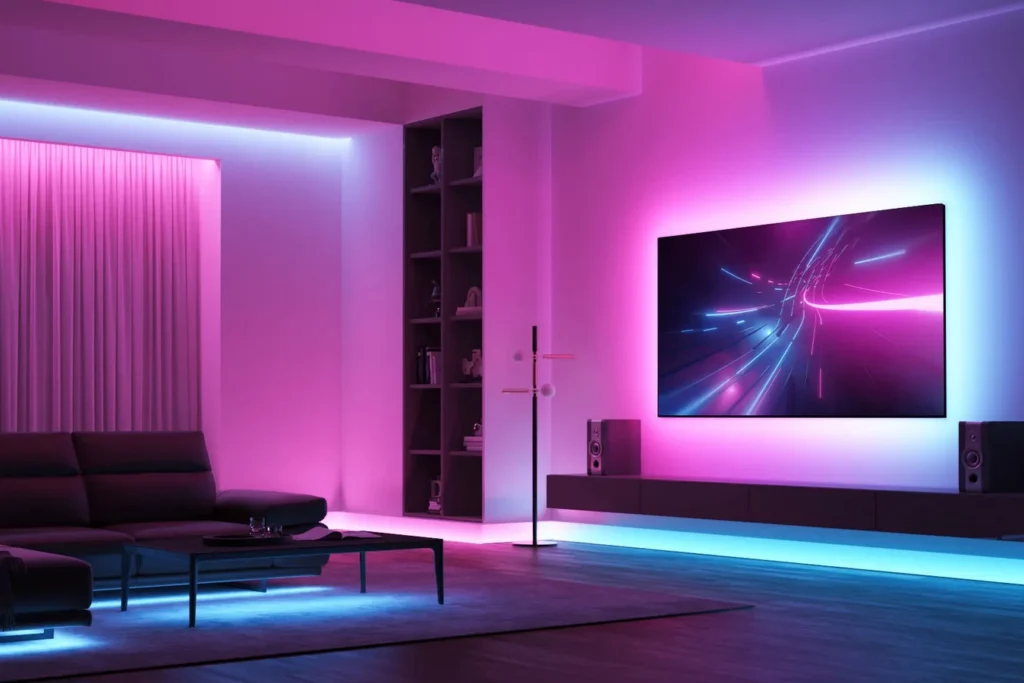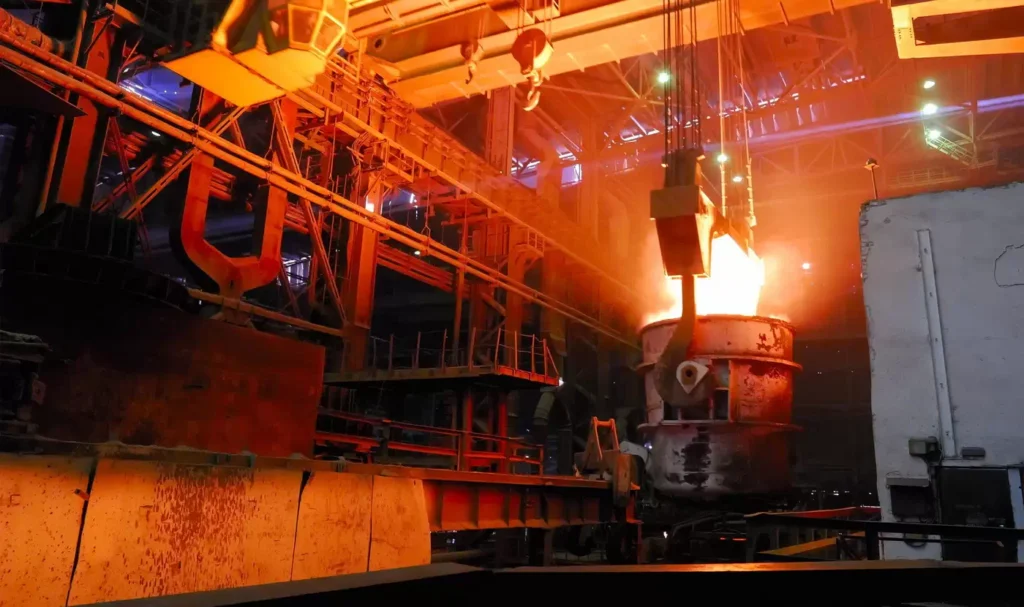목차
토글소개 LED 조명 색상과 그 중요성
조명의 세계는 다양한 종류의 LED 조명으로 인해 압도적일 수 있습니다. 집, 사무실, 공장, 스포츠 경기장 등 어떤 곳에 조명을 설치하든 적합한 조명 색상을 선택하는 것이 중요합니다. 적절한 분위기를 조성하는 데 도움이 됩니다.
주광색과 밝은 흰색은 용도와 설정이 다릅니다. 부드러운 흰색과 따뜻한 흰색 전구는 공간의 분위기를 바꿀 수 있습니다. 이 가이드는 이러한 옵션을 탐색하는 데 도움이 될 것입니다.
조명이 환경에 미치는 영향에 대한 자세한 내용을 확인하세요, 가시광선에 대한 도움말을 확인하세요.
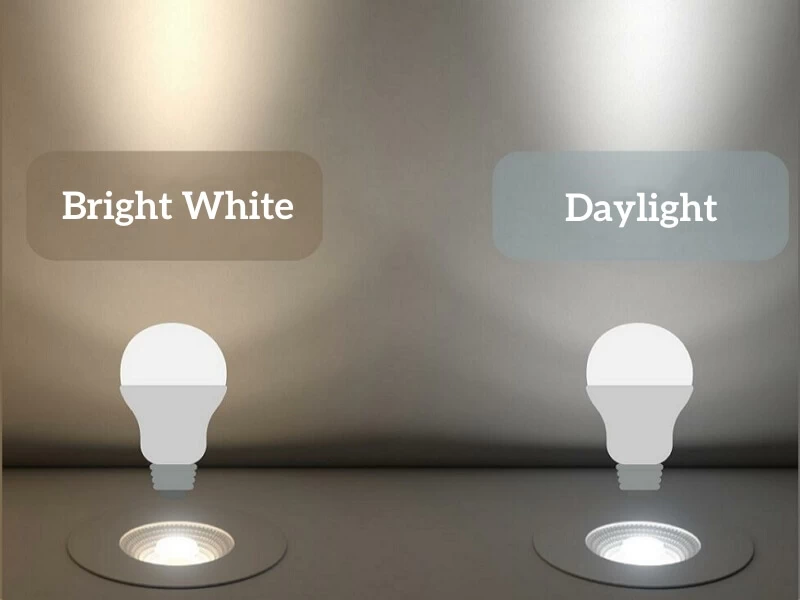
와트 및 켈빈에 대해 알아야 할 사항
다양한 유형의 LED 조명에 대해 알아보기 전에 와트와 켈빈을 이해하는 것이 중요합니다:
와트란 무엇인가요?
와트는 전구에서 소비되는 에너지를 나타냅니다. 와트가 클수록 램프가 밝아지고 전력 소비량이 많아지는데, 기존의 백열전구는 많은 와트를 사용했습니다.
반면 최신 LED 전구는 에너지 사용량이 적습니다. 하지만 여전히 높은 루멘 출력을 제공합니다. 올바른 전구를 선택할 때는 에너지 효율성을 보장하기 위해 와트를 고려하는 것이 중요합니다.
켈빈이란 무엇인가요?
켈빈은 LED 조명이 방출하는 빛의 색온도를 측정합니다. 켈빈이 높을수록 주광색 전구처럼 더 차갑고 푸른 빛을 냅니다. 낮은 켈빈은 소프트 화이트 전구처럼 따뜻하고 부드러운 빛을 생성합니다.
전구의 종류: 분류
다양한 유형의 LED 조명에 대해 알아보기 전에 와트와 켈빈에 대해 이해하는 것이 중요합니다. 주광색, 밝은 흰색, 부드러운 흰색, 차가운 흰색, 따뜻한 흰색 등이 이에 해당합니다.
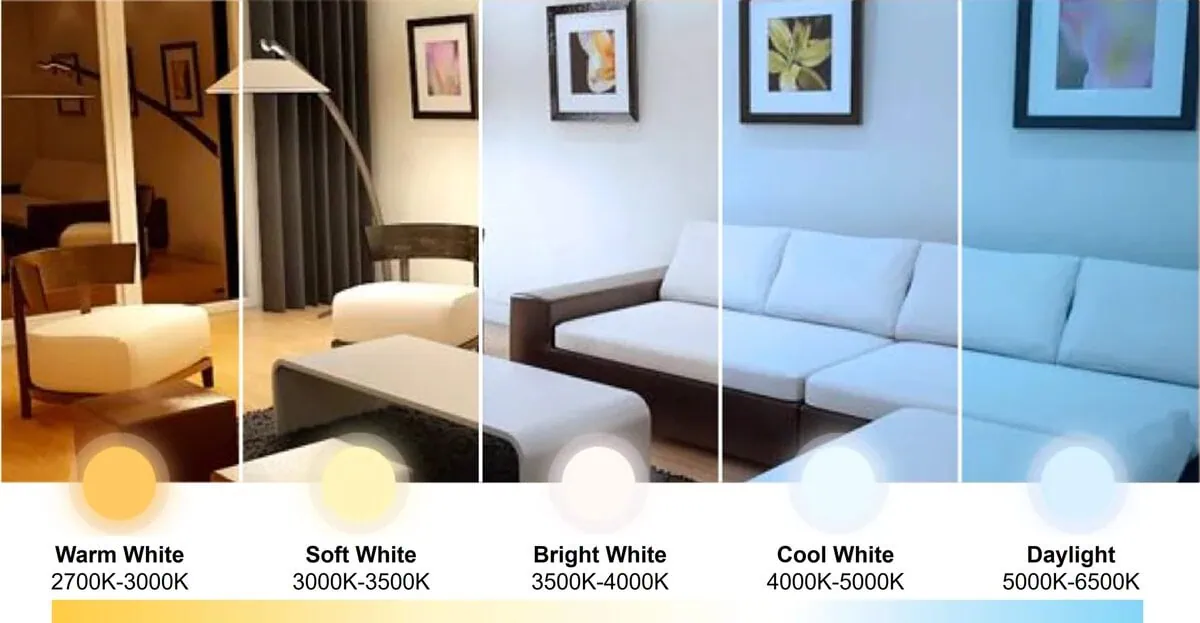
1. 밝은 흰색 대 주광색 전구
밝은 흰색 전구와 주광색 전구는 모두 선명한 흰색 외관 때문에 선택되는 경우가 많지만 용도는 다릅니다. 밝은 흰색 전구는 주방이나 사무실 등 선명도가 필요한 작업에 이상적입니다. 주광색 전구는 자연광처럼 보이도록 만들어졌습니다. 작업장이나 차고처럼 밝은 조명이 필요한 곳에 적합합니다.
상업용 전구는 쇼룸, 병원 또는 대형 사무실과 같은 장소에서 자주 사용됩니다. 최고의 주광색 전구를 선택하는 방법에 대해 자세히 알아보세요, 제품 페이지 방문하기.
핵심 차이점: 색온도
- 일광: 색온도는 일반적으로 5000K~6500K 범위입니다. 이 색온도는 한낮의 자연광을 시뮬레이션합니다.
- 밝은 흰색: 색온도는 일반적으로 3500K ~ 4100K 범위입니다. 따뜻한 흰색과 주광색 사이의 중간 정도입니다.
시각적 차이:
- 일광: 선명하고 시원하며 약간 푸른빛이 도는 흰색으로 매우 정확한 색 재현을 제공합니다. 선명함, 주의력, 집중력, 모던함, 청결함, 기술적인 분위기를 연출합니다. 빛이 선명하고 그림자 대비가 비교적 강합니다.
- 밝은 흰색: 순수하고 중성적인 밝은 흰색으로 탁월하고 자연스러운 색상 재현을 제공합니다. 상쾌하고 밝으며 효율적이고 균형 잡힌 중립적인 분위기를 연출합니다. 따뜻한 백색광보다는 '활기차고', 주광보다는 '친근하고' '자연스러운' 느낌을 줍니다. 그림자는 선명하지만 눈부시지 않습니다.
| 밝은 색상 | 시각적 특성 | 일반적인 애플리케이션 |
|---|---|---|
| Daylight | 한낮의 햇살과 비슷한 선명하고 깨끗한 시원한 백색광 | 주거용: 주방 카운터, 업무용 책상, 메이크업 공간 산업: 작업장, 실험실, 정밀 작업, 물류창고 상업용: 전자 디스플레이, 진료소, 신선식품 코너 스포츠: 체육관 코트, 라커룸, 눈에 잘 띄는 공간 |
| 밝은 흰색 | 중성적인 흰색, 깨끗하고 선명하며 자연스러운 밝기 | 주거용: 욕실, 복도, 일반 조명 산업: 사무실, 회의실, 복도 상업용: 소매점, 쇼룸, 레스토랑, 클리닉 스포츠: 피트니스 존, 워킹 트랙, 헬스클럽 |
2. 소프트 화이트와 웜 화이트 전구
소프트 화이트 전구는 따뜻한 노란색 톤의 빛을 발산하여 아늑한 분위기를 원하는 거실과 침실에 이상적입니다. 따뜻한 백색 전구는 아늑한 따뜻함을 제공합니다. 식사 공간이나 라운지에서 편안한 분위기를 연출하기에 좋습니다.
핵심 차이점: 색온도
- 소프트 화이트: 2700K - 3000K, 기존 백열등/양초의 따뜻함을 모방합니다.
- 따뜻한 흰색: 3000K - 3500K, 할로겐 램프/일출 및 일몰의 따뜻함을 모방합니다.
시각적 차이:
- 소프트 화이트: 뚜렷한 주황색/호박색 색조로 "노란색" 조명을 연출합니다. 더 풍부하고 느긋한 느낌으로 휴식과 프라이버시가 보장되는 분위기를 연출합니다.
- 따뜻한 흰색: 부드러운 황백색으로 소프트 화이트보다 약간 더 흰색입니다. 따뜻하고 편안하며 친근하고 자연스럽고 약간 활기찬 느낌을 줍니다.
| 밝은 색상 | 시각적 특성 | 일반적인 애플리케이션 |
|---|---|---|
| 소프트 화이트 | 따뜻한 노란색 색조로, 약간 감소할 수 있습니다.주거용: 침실의 메인 조명, 심야 거실의 주변 조명, 레스토랑의 촛불 저녁 식사 조명. 상업용: 양식 레스토랑, 바, 카페, 객실 및 복도 | |
| 따뜻한 흰색 | 물체 색상은 소프트 화이트보다 약간 더 선명한 디테일과 일반적으로 약간 더 나은 연색성으로 더 자연스럽고 따뜻하게 보입니다. | 주거용: 거실 메인 조명, 식당 메인 조명, 현관 조명 상업용: 레스토랑, 커피숍, 베이커리, 로비 라운지, 식료품 저장실 |

3. 차가운 흰색 대 밝은 흰색
쿨 화이트와 브라이트 화이트는 혼동하기 쉬운 두 가지 유형의 중성 및 쿨 화이트 조명입니다. 핵심적인 차이점, 시각적 구분, 선택 방법은 다음과 같습니다:
핵심 차이점: 색온도
- 쿨 화이트: 효율, 차분함, 모던함, 기술, 청결함을 나타내는 4000K - 5000K입니다.
- 밝은 흰색: 3500K - 4100K로 밝기, 산뜻함, 효율성, 균형, 자연스러움을 나타냅니다.
시각적 차이:
- 차가운 흰색: 차가운 흰색은 푸르스름한 색조가 있어 사물에 약간 시원한 색조를 줄 수 있습니다. 보다 이성적이고 진지한 분위기를 연출합니다.
- 밝은 흰색: 따뜻하거나 차가운 톤이 뚜렷하지 않은 순수한 중성 흰색으로, 사물이 가장 자연스럽게 균형 잡힌 상태로 보이도록 합니다.
주요 고려 사항:
- 차분하고 효율적이며 기술적으로 진보된 초고화질을 찾고 계신가요? 쿨 화이트(4000K-5000K)를 선택하세요.
예를 들어 수술실, 실험실, 전자 제품 공장 등이 있습니다. - 밝고 전문적이며 중성적이고 자연스러운 룩을 찾고 계신가요? 밝은 흰색(3500K-4100K)을 선택하세요.
예를 들어 사무실, 교실, 소매점 및 대부분의 일반 상업 지역이 이에 해당합니다. - 간단한 팁:
쿨 화이트 = 시원함, 기술, 진지함
밝은 흰색 = 중립성, 다용도성, 자연스러움

4. 주광색과 연한 흰색의 차이점
주광색과 연한 흰색은 색온도의 두 가지 극단으로, 시각적 경험과 적용 가능한 시나리오가 매우 다릅니다.
- 소프트 화이트: 색온도가 2700K-3000K인 이 조명은 따뜻한 노란색입니다. 약간 흐릿한 느낌으로 따뜻하고 편안하며 나른한 분위기를 연출합니다. 휴식 및 휴식 공간에 적합합니다.
- 일광: 색온도가 5000K-6500K인 이 조명은 한낮과 비슷한 시원한 흰색입니다. 상쾌하고 활기차며 약간 시원한 느낌을 줍니다. 집중도가 높은 작업 공간에 적합합니다.
| 유형 | 색온도(K) | 조명 외관 | 일반적인 사용 |
|---|---|---|---|
| Daylight | 5000K - 6500K | 푸르스름한 톤의 시원하고 선명한 흰색 | 사무실, 작업장, 독서, 작업 조명 |
| 소프트 화이트 | 2700K - 3000K | 노란빛이 도는 따뜻하고 아늑한 조명 | 거실, 침실, 주변 조명 |
최고의 전구를 선택하기 위한 주요 요소
필요에 가장 적합한 전구를 선택할 때 고려해야 할 몇 가지 요소가 있습니다:
- 밝은 흰색 또는 일광이 더 밝습니까?
브라이트 화이트와 주광색 전구의 가장 큰 차이점은 밝기입니다. 주광색 전구는 일반적으로 켈빈 등급이 높고 더 밝은 빛을 방출하여 세밀한 작업에 적합합니다. - 소프트 화이트와 웜 화이트의 차이점
두 가지 유형의 전구 모두 따뜻한 분위기를 연출합니다. 소프트 화이트 전구는 더 부드럽고 친밀한 분위기에 적합합니다. 따뜻한 백색 전구는 더 밝은 빛을 제공하므로 넓은 상업 공간에 적합합니다.
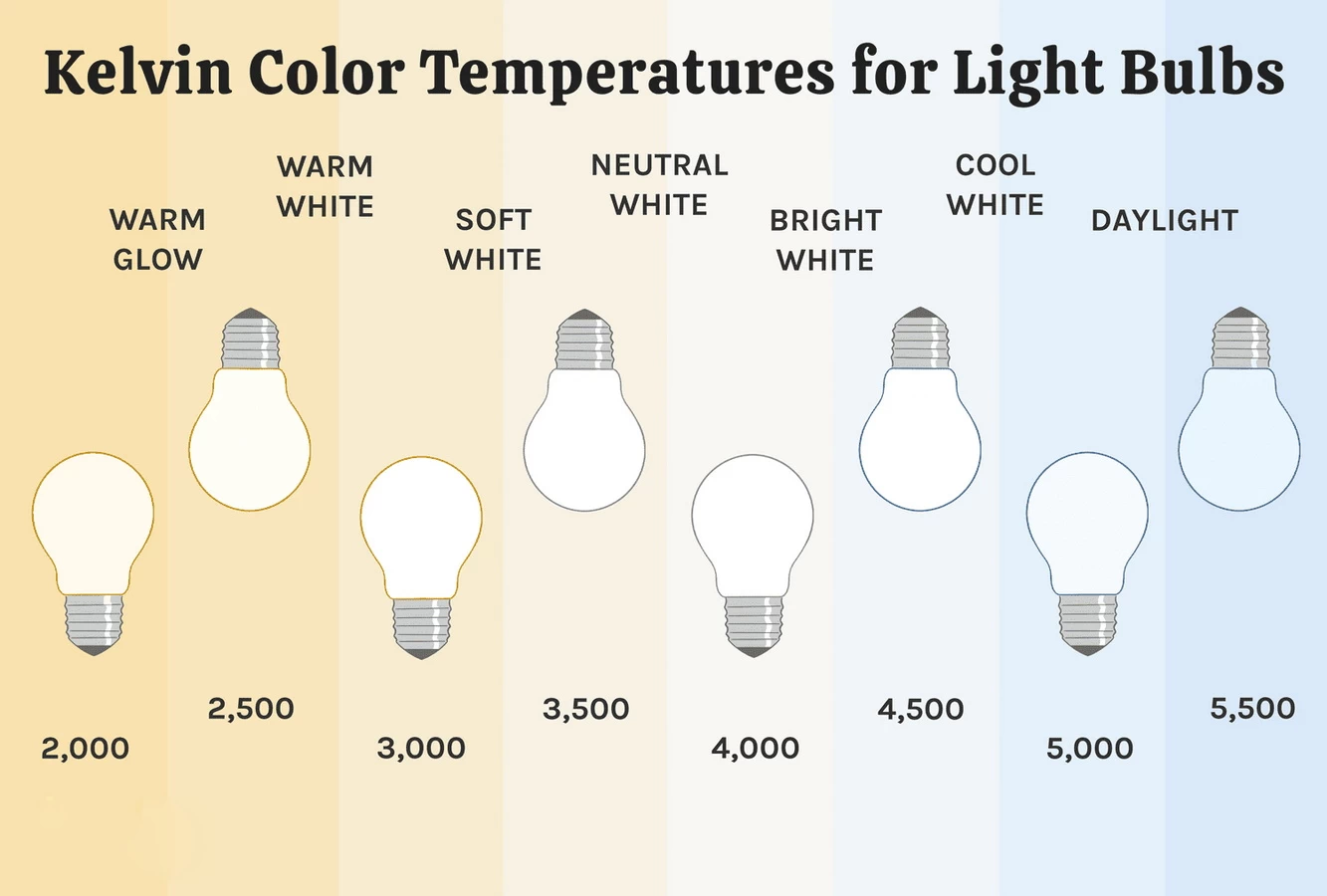
산업, 스포츠 및 상업용 애플리케이션
조명은 다양한 분야에서 중요한 역할을 합니다:
- 산업 애플리케이션
산업 환경에서는 조명이 밝고 안정적이어야 합니다. 창고, 공장 및 생산 라인에서는 주광색 전구가 선호됩니다. 밝은 백색 전구는 정밀도와 집중력이 필요한 영역에서 일반적으로 사용됩니다. - 스포츠 애플리케이션
스포츠 경기장의 경우 조명은 눈의 피로를 유발하지 않으면서도 선명한 가시성을 보장해야 합니다. 일반적으로 경기장, 경기장, 코트에서는 발광 효율이 높은 주광색 및 주광색 LED를 사용합니다. - 상업용 애플리케이션
사무실, 소매점, 쇼룸과 같은 상업 공간에서 조명은 첫인상을 결정짓는 요소입니다. 주광색은 선명함을 제공하고, 부드러운 흰색과 따뜻한 흰색 전구는 더욱 친근한 분위기를 연출합니다.
상업 공간에 적합한 조명을 선택하는 방법에 대한 자세한 내용을 확인하세요, 제품 페이지를 살펴보세요.
결론 결론: 조명 요구 사항에 맞는 올바른 선택하기
올바른 조명을 선택하려면 전구의 켈빈과 와트를 이해하고 용도를 고려해야 합니다. 공간에 적합한 전구를 선택하는 것이 중요합니다.
에너지가 많은 환경에서는 주광색 또는 밝은 흰색을 고려하세요. 아늑한 환경에는 부드러운 흰색 또는 따뜻한 흰색이 가장 적합합니다. 올바른 전구는 편안함과 기능을 크게 향상시킬 수 있습니다.
조명을 변경할 준비가 되셨다면 언제든지 다음과 같이 하세요. 문의하기전문 팀이 고객을 위한 맞춤형 조명 솔루션을 제공합니다.
사람들이 자주 묻는 질문
LED 조명에서 부드러운 백색광은 어떤 색인가요?
LED 조명의 부드러운 백색광은 기존의 백열등, 촛불 또는 노을의 따뜻한 빛과 유사한 호박색 또는 황색을 띠는 전형적인 저색상의 따뜻한 노란색 빛입니다. 따뜻하고 나른하며 편안한 느낌을 줍니다.
차가운 흰색과 밝은 흰색이 꽤 비슷해 보이는데 둘 중 하나를 선택해도 되나요?
차가운 흰색과 밝은 흰색은 시각적으로 매우 비슷하지만 약간 다른 분위기를 연출합니다. 차가운 흰색은 푸른빛이 도는 경우가 많아 작업 조명이나 작업 공간에 이상적입니다. 밝은 흰색은 약간 더 따뜻하거나 시원한 색조를 띠는 경향이 있습니다. 특정 분위기나 효과를 원하지 않는다면 두 가지 중 하나를 선택할 수 있으며, 일반적으로 차이는 미묘합니다.
밝은 흰색이 가장 일반적으로 사용되는 LED 조명인가요? 어떤 시나리오에서 가장 많이 사용되나요?
예, 밝은 흰색은 가장 일반적으로 사용되는 LED 색온도 중 하나입니다. 밝고 중성적이며 자연스러운 특성으로 인해 많은 가정, 상업 및 산업 공간에서 널리 사용됩니다.
예를 들어 주방, 욕실, 공부방, 거리, 소매점, 창고, 공장 복도 등에서 사용할 수 있습니다.
LED 조명에서 트루 화이트와 주광의 차이점은 무엇인가요?
트루 화이트: 4000K - 4500K 색온도, 순수한 중성 흰색, 밝고 전문적이며 눈부심 없이 자연스러운 색감. 트루 컬러와 편안한 조명이 필요한 장면에 이상적입니다.
일광: 5000K - 6500K 색온도, 푸르스름한 색조의 차가운 흰색. 높은 정밀도와 집중력이 필요한 전문 분야에 이상적입니다.


